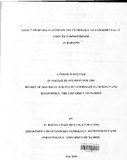| dc.description.abstract | The objective of this study was to determine the effect of rosiglitazone, on the pathology of
endometriosis in a baboon model. It was a prospective, randomised, placebo-controlled
study, conducted at the Institute of Primate Research in Nairobi, Kenya. Endometriosis was
induced using intrapelvic seeding of eutopic menstrual endometrium in 12 female baboons
that had at least one menstrual cycle while in captivity.
Laparoscopy was performed on each of the 12 baboons. Menstrual endometrial tissue was
extracted from each baboon by curettage, and one gram of endometrium was then seeded
onto several peritoneal sites to induce endometriosis. About 34 - 68 days after the induction
of endometriosis, a pre-treatment laparoscopy was performed in the baboons to assess the
extent of endometriosis. Thereafter, the 12 baboons were randomised into three groups that
were treated daily for 30 days as follows; placebo group (n = 4) received phosphate -
buffered saline (PBS) tablets once a day orally, for 30 days. The positive control group (n =
4) received a gonadotrophin releasing hormone antagonist, (Ganirelix acetate'"), at a daily
dose of 125 ug/day subcutaneous for 30 days. Finally, the experimental group (n= 4)
received 2 mg rosiglitazone, (Avandia") by mouth daily for 30 days. A third and fmal
laparoscopy was performed 30 days after the start of treatment to record the extent of
endometriosis.
Endometriosis lesions were examined at laparoscopy and classified morphologically as
typical blue-black, white plaques with pigmented spots, red vesicular, red hemorrhagic, red
polypoid, white nodules, white plaques, white clear vesicles, flimsy adhesion, or dense
adhesion. During the procedure, a video recording was performed to document the number
and surface area of the endometriosis lesions. Blood for haematology and serum for clinical
pathology was collected during the time of pre-treatment laparoscopy and at the fmal
laparoscopy. The baboons were then euthanised by administrating 60mg/kg body weight of
Sodium Pentobarbitone, (Euthatal~, intravenously and immediately thereafter a complete
post mortem was performed.
Lesion samples were obtained and fIxed in 10% neutral buffered formalin to confirm the
histological features of endometriosis. The endometriosis lesions were scored on a scale of 0
to +4 in order to monitor the effects of the drug. The scoring scale was designed on the basis
of a trial run that identified all the possible histological features that enabled an allocation of
scores of 0 - 4. Intensity, severity and quantitative parameters within the lesions formed a
subjective basis of scoring. This was not a blinded scoring.
Biochemical tests were carried out in serum to assess the adverse effects of the drug on the
liver function. The liver function assays included analyses for total protein content, alkaline
phosphatase (ALK) , aspartate aminotransferase (AST/SGOTI AAT) and bilirubin. Kidney
function tests included creatinine and urea tests. The endometriosis lesions were assessed
and scored for histopathologic changes and features.
It was noted that the surface area of endometriotic lesions were significantly lower in
rosiglitazone - treated baboons when compared with the placebo group. Baboons treated
with rosiglitazone or (Ganirelix acetate'") had a greater relative reduction in surface area
(mm') of peritoneal endometriotic lesions than controls. The extent of epithelial degenerative
changes, including nuclear pyknosis and focal epithelial erosions were increased in treated
baboons.
Rosiglitazone effectively reduced the burden of endometriosis disease in a baboon model. In
one rosiglitazone treated animal, the level of degeneration in the endometriosis lesion was
severe enough to cause epithelial necrosis. There were also significant degenerative changes
of endometriotic stromal cells (ESCs) in the treated group. The experimental induction also
produced some Stromal endometriosis (i.e. endometriosis without glands).
The systemic effects of rosiglitazone on baboons were analysed by comparing the frequency
of appearance of histological features among the groups. Briefly, the following significant
observations were recorded in rosiglitazone treated group compared with the placebo and
GnRH treated group; pulmonary edema & hemorrhages; hepatic bile cananaculi surrounded
by inflammatory cells and bile duct hyperplasia. Haematology also showed significant
changes when a pre and post-treatment data was compared; there was an increase in
haemoglobin values in the placebo and Rosiglitazone treated group; a significant increase of
total plasma protein in GnRH group; an increase in eosinophil count in the rosiglitazone
treated group and an increase in plasma fibrinogen in the GnRH group. Serum chemistry
showed no significant changes.
The overall weighted appearance of the lesion types suggests that rosiglitazone may deter the
development of newer endometriotic lesions. This conclusion is supported by the
observation that gross and histopathology changes showed a significant reduction in surface
area of lesions and an increase in degenerative and epithelial desquamation of endometriosis
in rosiglitazone and GnRH treated baboons. The baboon model holds promise that a
thiazolidinedione drug may be helpful in women with endometriosis. | en |

